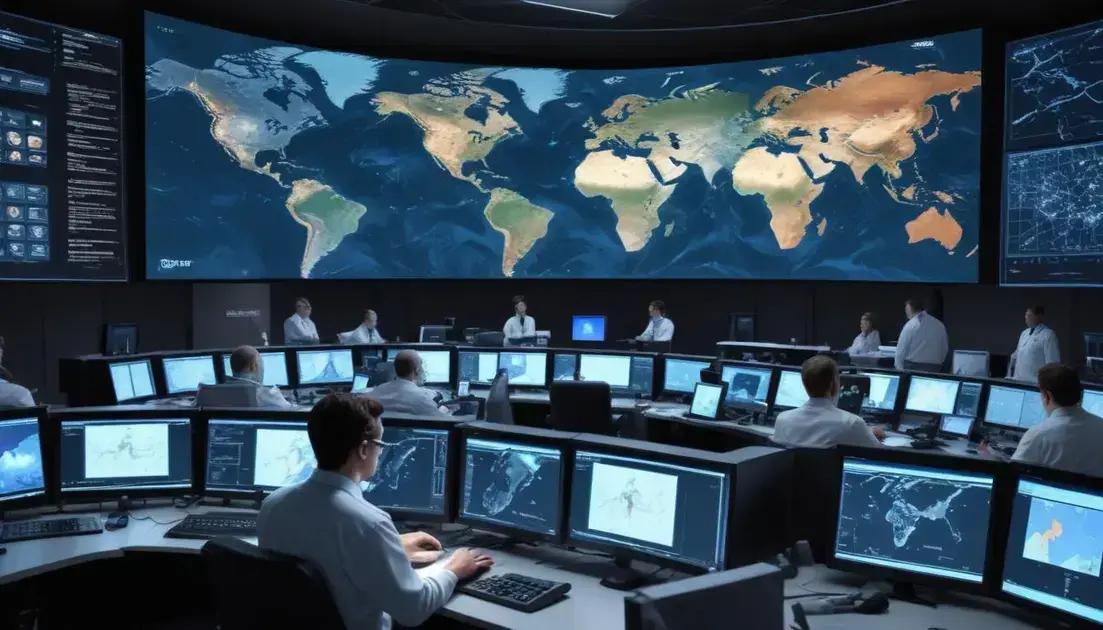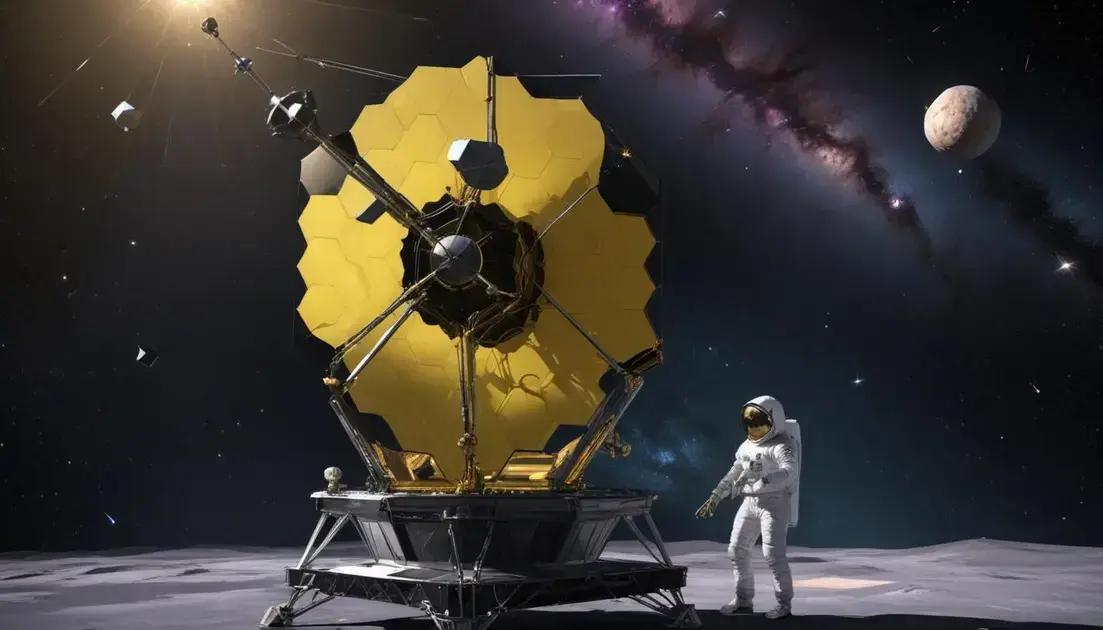Space exploration milestones 2025: what’s next?
Anúncios
Space exploration milestones involve key missions to Mars, advancements in lunar exploration, and the vital role of private companies and international collaborations enhancing our understanding of the universe.
Space exploration milestones 2025 are set to redefine our understanding of the universe. Have you ever wondered what groundbreaking developments await us? Let’s dive into the exciting journeys ahead!
Anúncios
Key missions to watch in 2025
In 2025, several key missions will capture the world’s attention in the realm of space exploration. These missions are pivotal for advancing our knowledge of the cosmos and ensuring the future of humanity beyond Earth.
One highlight is NASA’s Artemis II, which aims to conduct a crewed flight around the Moon. This mission will pave the way for future lunar landings and is a critical step towards sustainable exploration of the Moon.
Anúncios
Other Notable Missions
Another exciting project is the James Webb Space Telescope (JWST) which, although launched in 2021, will be unveiling stunning discoveries in 2025. This telescope will observe the formation of distant stars and galaxies, providing insights into the early universe.
-
🌌 The European Space Agency’s JUICE mission will explore Jupiter’s moons, particularly Europa, which may harbor conditions suitable for life
-
🚀 SpaceX’s Starship program will continue its efforts towards future Mars missions, aiming for a potential manned mission in the late 2020s
For more detailed information, visit NASA’s official website at nasa.gov to stay updated on these groundbreaking missions.
Breakthrough technologies in space travel
Breakthrough technologies in space travel are transforming how we explore the universe. Innovations in propulsion, materials, and robotics are paving the way for safer and more efficient missions.
One notable advancement is the development of ion propulsion systems, which offer greater fuel efficiency than traditional chemical rockets. These systems allow spacecraft to travel longer distances while consuming less fuel, making them ideal for deep space missions.
Key Innovations
The use of 3D printing in spacecraft construction is another exciting breakthrough. This technology enables the creation of complex parts on-site, reducing the need to transport materials from Earth.
- 🚀 Reusable rockets, such as those developed by SpaceX, are revolutionizing launch costs and frequency.
- 🛠️ Advanced materials, like lightweight composites, enhance spacecraft durability while reducing overall weight.
For more information on these technologies, check resources from NASA at nasa.gov, which highlight their ongoing projects and advancements in space exploration.
The role of private companies in space exploration
The role of private companies in space exploration has become increasingly significant in recent years. These companies are driving advancements, reducing costs, and expanding access to space.
Companies like SpaceX and Blue Origin are among the leaders, developing new technologies that enable more frequent launches and innovative mission designs. This competition is pushing government agencies to work more efficiently and effectively.
Key Contributions
Private enterprises are not just launching rockets; they are involved in various aspects of space exploration, including:
For further insights on how private companies shape space exploration, visit the website of the Space.com to learn more about recent developments and missions.
International collaborations on major projects

International collaborations on major space projects are essential for advancing exploration and technology. These partnerships bring together resources, expertise, and diverse perspectives to tackle complex challenges in space.
One prominent example is the International Space Station (ISS), which involves collaboration between NASA, Roscosmos, ESA, JAXA, and CSA. This project fosters scientific research and international teamwork, changing the way we understand life in space.
Collaborative Initiatives
Collaborations extend to various ambitious projects, including:
- 🌙 Artemis Program – A NASA-led initiative with support from international partners to return humans to the Moon.
- 🔴 ExoMars – A joint mission between the European Space Agency and Roscosmos aimed at exploration of the Martian surface.
- 🛰️ James Webb Space Telescope – Developed collaboratively by NASA, ESA, and the Canadian Space Agency to study the universe’s earliest galaxies.
For more information on international space collaborations, check out the European Space Agency’s website, which details ongoing partnerships and project updates.
Upcoming astrobiology studies and their implications
Upcoming studies in astrobiology are set to enhance our understanding of life beyond Earth. These investigations aim to uncover the potential for life on other planets and moons, focusing on the conditions that support biological processes.
One exciting development is the exploration of Europa, one of Jupiter’s moons. Scientists believe that Europa has a subsurface ocean, which may harbor the ideal environment for life.
Key Research Areas
Astrobiology encompasses various critical research areas, including:
| 🔬 Field | 📌 Description |
|---|---|
| 🌌 Exoplanet Studies | Focuses on locating planets in the habitable zones of stars, where conditions may support liquid water and life. |
| 🌋 Extreme Environments | Studies Earth’s harshest environments to model how life might exist under similar conditions elsewhere. |
| 🧪 Chemical Precursors | Investigates organic molecules and prebiotic chemistry to understand the origin and distribution of life-supporting compounds. |
For more detailed and up-to-date information on these studies, visit the NASA Astrobiology website, which offers insights into ongoing missions and research.
Exploring Mars: What to expect next
Exploring Mars is one of the biggest goals for space agencies and private companies in the coming years. With numerous missions planned, there is a lot to expect as we aim to learn more about the Red Planet.
NASA’s Perseverance rover is currently on Mars, collecting data and samples. It is expected to pave the way for future human missions by finding signs of past life and preparing for future astronauts.
Future Missions
Several significant missions are in the pipeline that could change our understanding of Mars:
-
🌕 The Artemis program aims to send astronauts to the Moon and use it as a stepping stone for future missions to Mars
-
🪐 The Mars Sample Return mission plans to bring back samples collected by Perseverance to Earth for detailed analysis
-
🚀 SpaceX’s Starship is being developed to eventually carry humans to Mars, potentially in the late 2020s
For more insights into upcoming missions to Mars, visit the NASA Mars Exploration website, which provides the latest news and updates.
Milestones in lunar exploration
Milestones in lunar exploration have significantly shaped our understanding of the Moon and its potential for future missions. Various lunar missions have marked key achievements in science and technology.
The first milestone was the Apollo 11 mission in 1969, where humans landed on the Moon for the first time. Astronauts Neil Armstrong and Buzz Aldrin collected samples and conducted experiments, paving the way for future exploration.
Significant Achievements
Recent milestones include:
- 🇮🇳 The Chandrayaan-2 mission by India, which aimed to explore the Moon’s south pole and enhance our understanding of lunar water.
- 🌕 The NASA Artemis program, which plans to return humans to the Moon and establish a sustainable presence by the end of the decade.
- 📦 The upcoming CLPS initiative (Commercial Lunar Payload Services) that will utilize private companies to deliver scientific equipment to the lunar surface.For more information on lunar missions and achievements, visit the NASA Moon website for updates on ongoing projects and future plans.
The future of telescopes and space observatories

The future of telescopes and space observatories holds great promise for advancing our understanding of the universe. Upcoming projects aim to study distant galaxies, dark matter, and the formation of stars.
New technology is allowing scientists to build more powerful instruments that can capture clearer images and collect more data than ever before. The James Webb Space Telescope is a flagship mission that will greatly enhance our ability to explore the cosmos.
Upcoming Projects
Several exciting telescope projects are set to launch in the near future:
In summary, the future of space exploration is bright
With exciting milestones ahead, such as missions to Mars and advancements in lunar exploration, our understanding of the universe is set to grow rapidly.
The role of private companies and international collaborations is also crucial in driving these changes, while upcoming advancements in telescopes and observatories promise to unveil new cosmic mysteries.
As we look forward to these developments, it is clear that space exploration will continue to inspire and challenge us as we seek to expand our knowledge of the cosmos.
FAQ – Frequently Asked Questions about Space Exploration
What are the key missions planned for Mars exploration in the coming years?
NASA’s Perseverance rover is currently exploring Mars, and upcoming missions like the Mars Sample Return are expected to bring samples back to Earth for study.
How are private companies contributing to space exploration?
Private companies like SpaceX and Blue Origin are developing innovative technologies for space travel, supporting missions to the Moon and Mars, and even launching satellites.
What advancements can we expect from future telescopes?
Future telescopes, like the James Webb Space Telescope and NASA’s Roman Space Telescope, will provide deeper insights into the universe, including studies on dark energy and exoplanets.
How do international collaborations impact space projects?
International collaborations combine resources and expertise, enabling countries to work together on missions like the International Space Station and joint lunar exploration efforts.
Where can I find more information about upcoming space missions?
You can visit official space agency websites like NASA and ESA for the latest updates, mission details, and research findings in the field of space exploration.







